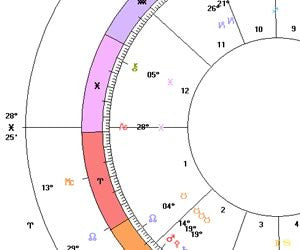How to Calculate Progressed Angles
The Problem Calculating Progressed Angles
by Steven Forrest
How to progress the four angles? The question is difficult and in all honesty it lies on the far side of my own understanding of astrology’s various spherical coordinate systems.
All the systems I know are based on progressing the Midheaven—somehow—then deriving the current Ascendant based on the latitude of the birth place.
We can progress the MC by Solar Arc. In this method, see how far the Sun has progressed by standard “secondary progression” methods and then add that same number of degrees to the Midheaven. This is based on the familiar day-for-year method of progression. If the Sun has progressed 20° since you were born and your natal Midheaven is at 5° Aries then your progressed MC is currently passing through 25° Aries (5° + 20° = 25°).
Solar Arcs - Your Internal Development Clock
 Solar Arcs operate like the genetic code of a seed. Similar to Progressions, they are an internal developmental clock hard-wired into your birthchart. Certain possibilities arise right on schedule as you come to the evolutionary crossroads they mark, just as an oak tree might sprout green leaves every Spring and watch them turn to red and gold each Autumn. Solar arcs are reliable, and no astrologer doing “current development” work is playing with a full deck without them.
Solar Arcs operate like the genetic code of a seed. Similar to Progressions, they are an internal developmental clock hard-wired into your birthchart. Certain possibilities arise right on schedule as you come to the evolutionary crossroads they mark, just as an oak tree might sprout green leaves every Spring and watch them turn to red and gold each Autumn. Solar arcs are reliable, and no astrologer doing “current development” work is playing with a full deck without them.
We can also use the Naibod method of progressing the Midheaven. This is very similar, except that instead of using the actual daily motion of the Sun, we use its average daily motion, which is 59’08"—a little less than one degree.
Solar Arc and Naibod produce very nearly identical results.
When we say “progressions” with the planets we mean “secondary progressions.” Method: if you are forty years old, look in the ephemeris for the year you were born, and count forty days ahead from your birthday. The positions of the planets on that day are your current progressed positions. But how can we apply that idea to the four Angles?
Each day, the Ascendant passes through the complete 360° of the Zodiac. Every sign rises once every day, in other words. So technically, by this method of progression, each year would see the four Angles make a complete circuit of your chart. This is actually a legitimate method of calculating progressions. It is called Daily Houses. But these Angles have a quick, triggering effect, like the transits of the inner planets. We tend not to use them in more evolutionary, thematic kinds of astrology.
Matrix Winstar software has a method of progressing the Angles which they call "Secondary MC." I’ve used it with good results over the years, although Naibod/Solar Arc works well too. I asked Stephen Erlewine how these Matrix calculations were made. He told me, “The first attempt was to duplicate what most astrologers were doing by hand at that time, and we call it Secondary MC. The sun’s position is calculated for the progressed date using one-day-equals 365.25 days, then the solar arc is calculated from that position and that arc is added to the natal MC and the houses derived. But instead of using the arc along the ecliptic as in the solar arc method, it is added along the equator since that more closely approximates the Midheaven that our customers were used to using, and, of course, the right ascension of the Midheaven is the basis of any house system.” See below for some definitions.
 Astrology, as we practice it, is based on the familiar Ecliptic—the twelve signs, defined by the Equinoxes and the Solstices. You can also project earth’s Equator out onto space, and derive the Celestial Equator that way. Declination then corresponds to latitude on Earth and Right Ascension (to which Stephen referred) to longitude. As we calculate longitude on earth based on the Greenwich meridian near London, we call the point of the Vernal Equinox 0° of Right Ascension.
Astrology, as we practice it, is based on the familiar Ecliptic—the twelve signs, defined by the Equinoxes and the Solstices. You can also project earth’s Equator out onto space, and derive the Celestial Equator that way. Declination then corresponds to latitude on Earth and Right Ascension (to which Stephen referred) to longitude. As we calculate longitude on earth based on the Greenwich meridian near London, we call the point of the Vernal Equinox 0° of Right Ascension.
Progressing the four Angles is obviously fairly technical territory. Further complicating the picture, some astrologers progress the MC by Naibod or by Solar Arc, but along the axis of Right Ascension rather than along the Ecliptic. There are, in other words, a great variety of methods for progressings the four Angles. As with all things in astrology, the proof of the pudding is the correspondence of any of these techniques with your own experience.
How to Calculate the Progressed Angles
Winstar
In Winstar extended options, click the drop down arrow next to the second chart field. Then select Secondary Charts > Progressed Chart. Under progression method select "Secondary." Under Progressed Angles select "Secondary MC."
Solar Fire
Go to Preferences > Edit Settings. Select the Progs/Dirns tab. Under Chart Angle Progression select SA in Long.
Copyright 2016 Seven Paws Press

